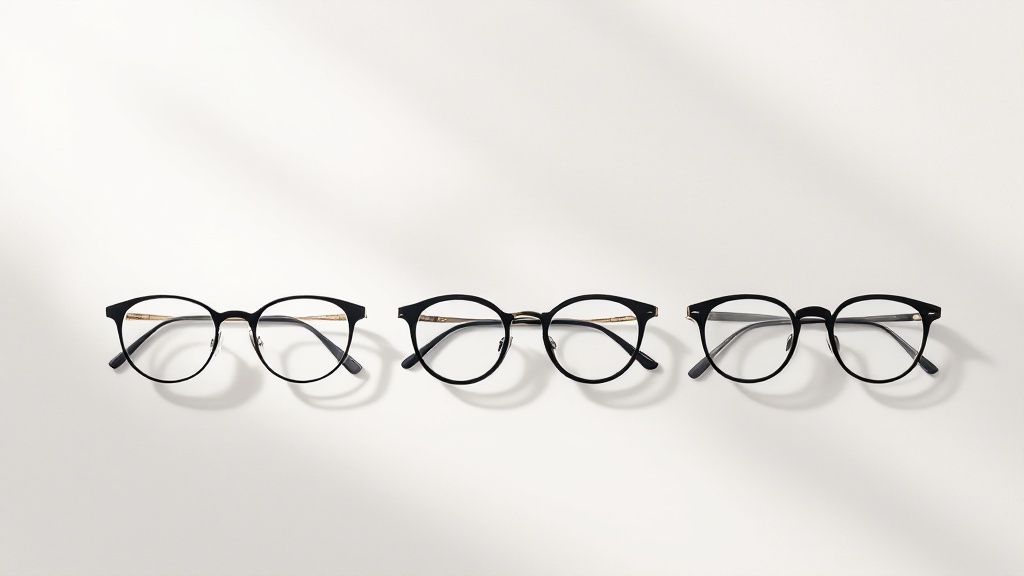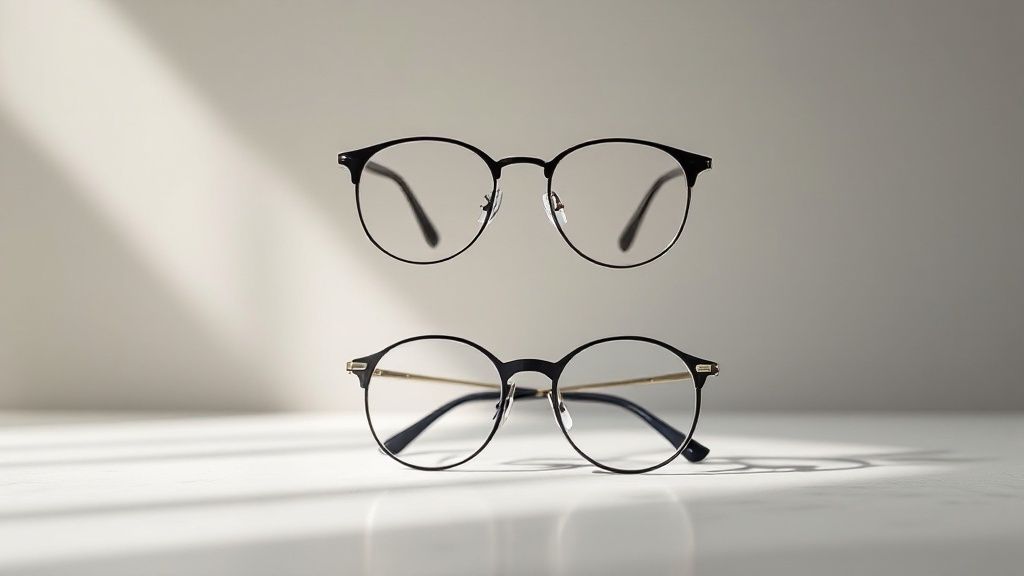
Best Glasses for Small Faces That Actually Fit
Finding the right glasses for a small face really boils down to three things: frame width, lens size, and bridge fit. Frames that are too wide can totally overwhelm your features, while oversized ones are constantly sliding down your nose. The perfect pair should feel secure, stay put, and just work with your facial structure.
Your Search for the Perfect Fit Ends Here
If you have a small face, you already know the struggle is real. Hunting for glasses that don't make you look like you're playing dress-up in an adult's closet can feel hopeless. But the good news is, the eyewear industry is finally catching on, making it easier than ever to find frames that flatter, not flatten. This guide will cut through the noise with practical advice you can actually use.
The eyewear market has exploded, which means more options for everyone. Glasses designed for smaller faces typically have a frame width between 120-128 mm, much narrower than the average 135 mm adult size. Many also feature adjustable nose pads for a truly comfortable, custom fit. If you're curious about the industry's growth, you can find more insights on the expanding eyewear market.
Understanding Key Measurements
Before you start shopping, it’s incredibly helpful to get familiar with the three numbers that make all the difference. Think of these as your secret weapon for finding that perfect pair.
- Frame Width: This is the big one—the total horizontal measurement of the frames from one end to the other. For a small face, getting this right is crucial to avoid that dreaded look where the frames stick out way past your temples.
- Lens Size: Also called "eye size" or lens width, this number tells you the horizontal diameter of one lens. A smaller lens size helps you dodge the "bug-eye" effect.
- Bridge Fit: This is the part that rests on your nose. A good fit here is everything; it keeps your glasses from slipping down or sitting weirdly high on your face.
The goal isn't just to find smaller glasses. It's about finding glasses that are proportionally balanced to your unique features. Paying close attention to these core measurements will transform your shopping experience from frustrating to fun and successful.
Getting these measurements right is the first step. To make it even easier, here's a quick cheat sheet with the ideal ranges for small or petite faces.
Key Measurements for Small Face Frames
| Measurement | Ideal Range for Small Faces | Why It Matters |
|---|---|---|
| Total Frame Width | 120mm – 128mm | Ensures the frames don't extend beyond the sides of your face, creating a balanced look. |
| Lens Width (Eye Size) | 46mm – 50mm | Prevents the lenses from overpowering your eyes and appearing too large for your features. |
| Bridge Width | 15mm – 19mm | A narrower bridge provides a secure, no-slip fit on a smaller or slender nose. |
| Temple Arm Length | 130mm – 135mm | Shorter arms ensure the glasses sit comfortably and securely behind your ears without extending too far. |
Keep these numbers handy when you browse online or visit an optician. They're your roadmap to finding a pair that feels like it was made just for you.
How to Confidently Measure for Glasses at Home
Finding glasses that truly fit a small face isn't just about style—it starts with your unique measurements. Forget the confusing tools and industry jargon. You can get the precise numbers you need right from the comfort of your home, which makes shopping online or in-store so much easier.
The whole point is to figure out key dimensions like your face width and pupillary distance (PD). You can even use a standard credit card for a quick reference; its width is surprisingly close to an average lens size, giving you a fast visual gut-check against your face.
This infographic breaks down the right way to measure your face, zeroing in on that all-important temple-to-temple distance for the overall frame width.
As you can see, getting it right is crucial. Even a few millimeters can be the difference between a pair that fits perfectly and one that's constantly sliding down your nose.
Decode Your Current Frames
Probably the simplest trick in the book is to use a pair of glasses you already own and love. Take a look at the inside of the temple arm. You should see a little series of three numbers that looks something like this: 50-18-135.
Here’s what they mean:
- Lens Width (50): The first number is the horizontal width of one lens, measured in millimeters.
- Bridge Width (18): The second number tells you the distance between the two lenses.
- Temple Arm Length (135): The last number is the full length of the arm, from the hinge all the way to the tip.
Think of these numbers as your personal blueprint for finding new frames that will fit just as comfortably. If you want a deeper dive, our complete guide explains how to measure eyeglass frames in more detail.
Don't get too hung up on finding an exact match for these numbers every single time. Treat them as a reliable starting point—as long as you stay within a 2-3mm range, you'll almost always land on a comfortable fit.
This idea of getting measurements right isn't just for glasses, of course. It applies to other accessories too, and you might find this a guide to achieving a perfect fit with measurements useful for a broader perspective. Once you have your numbers, you’re all set to find frames that feel like they were made just for you.
Choosing Frame Shapes That Complement Petite Features

Once you've nailed down your measurements, the real fun begins: choosing a shape. This is where you can truly express your style. For smaller faces, the goal is to find a frame that brings balance and definition without overwhelming your natural features.
Some shapes are just naturally fantastic for petite proportions. Styles like cat-eye, round, and oval frames tend to be go-to winners. A classic cat-eye, for instance, has a subtle upswept angle that draws the eye upward, creating a natural lifting effect. In the same way, softer, rounded frames can beautifully contrast a more angular jawline.
Smart Choices For A Balanced Look
While personal preference is king, a few guidelines can point you toward the most flattering options. Heavy, thick, or dramatically oversized frames can easily swallow up a petite face, so you'll usually have better luck with lighter, more delicate designs.
Here are a few things I always tell clients to look for:
- Thinner Rims: Stick to frames made from thin acetate or metal. They give you all the structure you need without adding too much visual weight.
- Clear or Light-Colored Materials: Translucent or light-hued frames are amazing for creating a softer look that doesn't dominate your face.
- Upswept Angles: Look for styles with subtle upward curves, like a classic cat-eye or a browline frame. They add just the right amount of lift and dimension.
The key is proportion. You want your glasses to be a feature, not the feature. The right shape should feel like a natural extension of your personal style.
While many styles work, don't overlook square and rectangular frames. There's a reason these shapes make up over 53% of global eyewear inventory—their clean, classic lines scale down perfectly for smaller faces without losing their impact.
To see how your frames fit into your complete look, it can be helpful to check out some general styling advice for petite women. And for a much deeper dive into how different shapes work with various face types, our complete guide on how to choose glasses is a great resource.
The Best Frame Materials for All-Day Comfort
When you're trying to find the perfect glasses for a small face, the material is just as critical as the fit itself. I’ve seen it time and time again: a heavy frame will constantly slip down your nose, create sore spots behind your ears, and completely ruin an otherwise great style.
The goal is simple—find a material that’s durable without being bulky. For small faces, lightweight materials are your absolute best friend. They make your glasses feel almost weightless, so you can wear them comfortably all day long.
Top Choices for Lightweight Frames
Acetate is a fantastic option. While it's often used for those thicker, bolder styles, modern thin-cut acetate frames are surprisingly light and flexible. Plus, they come in a seemingly endless variety of colors and patterns, giving you a rich visual depth that plain plastic just can't match.
Another top contender is titanium. This is a premium metal, and for good reason—it's incredibly strong, won't corrode, and is astonishingly lightweight. Frames made from titanium are typically ultra-thin, giving off a minimalist and sophisticated vibe that's perfect for not overwhelming petite features. Think of it as a smart, durable investment for years of wear.
Think of the frame material as the foundation of your comfort. Choosing a lightweight option like thin acetate or titanium ensures your glasses will feel as good at the end of the day as they did when you first put them on.
Many people who spend hours at a desk also need computer glasses. For these situations, I always suggest looking into blue light glasses from a reputable brand like PROSPEK. They combine lightweight, comfortable frames with high-quality blue light filtering lenses, which is the perfect setup for reducing digital eye strain without adding extra weight to your face.
Selecting Lenses That Protect Your Eyes from Screens

Finding frames with the perfect dimensions is a huge win, but what you put in them is just as critical for your daily wellness. We all spend so much time staring at screens, and it takes a toll, leading to digital eye strain, nagging headaches, and even messed-up sleep. Upgrading your lenses isn't just a nice-to-have; it's a must for modern eye care.
The two most effective upgrades you can make are an anti-reflective (AR) coating and blue light filtering. An AR coating cuts down on that annoying glare from overhead lights and your own monitor, which gives you a much clearer, more comfortable view. It’s a small change that makes a huge difference in how much you squint and how tired your eyes feel.
Blue light filtering, though, is the real game-changer for anyone who spends their days in front of a screen.
Why Blue Light Filtering Matters
The high-energy visible (HEV) blue light that our devices blast out has been linked to eye fatigue and sleep cycle disruption. It's the reason your eyes feel so fried after a long day. Specialized lenses are built to filter out the most intense parts of this light, giving your tired eyes some much-needed relief.
If you are looking for high-quality computer glasses, PROSPEK glasses are an excellent choice. Their advanced lens technology is specifically designed to combat digital eye strain. By filtering out the harshest blue light, PROSPEK glasses can help reduce headaches, alleviate eye fatigue, and improve your sleep quality.
Think of blue light lenses as a protective shield for your eyes. You wear sunglasses to block UV rays, right? These lenses do the same thing for the harsh light from your screens, making them an essential tool for anyone glued to a computer or phone.
More and more people are catching on to this. The eyewear market in the United States was valued at nearly $38 billion in 2023, and a big driver of that growth is the demand for protective lenses thanks to all our screen time. You can dig into more details about the U.S. eyewear market on grandviewresearch.com.
Choosing the right lens features is a crucial part of finding the best glasses for small faces. If you want to get into the nitty-gritty, we have a detailed article that explores the different lens options for glasses that can boost your vision and comfort. It's a key piece of the puzzle, whether you need a prescription or not.
Common Questions About Finding Small Glasses
Even when you've done your homework and taken all the right measurements, a few questions inevitably pop up. Finding clear, straightforward answers can be the difference between a frustrating search and finally landing that perfect pair. Let's dig into some of the most common ones.
Are Petite and Narrow Fit Glasses the Same Thing?
Good question. While you’ll often see these terms used interchangeably, there's a subtle but key difference. ‘Petite’ typically refers to a frame that’s proportionally smaller in every way—think lens height, width, and even the length of the arms (temples). It’s designed to be smaller all over.
‘Narrow fit’, however, usually points to a frame with a specifically reduced lens width and bridge. This makes it a great choice for faces that are more slender than they are short. Honestly, searching for either term is a solid starting point. The real secret is to look past the label and focus on the numbers. A total frame width between 120-128mm is almost always your North Star for a fantastic fit.
Can I Wear Oversized Glasses with a Small Face?
You absolutely can! The key is to find what the industry calls a “petite oversized” style. These frames nail that trendy, statement-making look you’re after but are built on a smaller frame chassis.
What that means is they have a narrower total width and bridge, so they won't constantly slide down your nose or swallow your features whole. To pull this off, my go-to recommendation is to look for oversized shapes made from thin metal wire or transparent acetate. These materials give you the vibe of an oversized frame without adding a ton of visual weight, keeping everything balanced and chic.
The secret to pulling off a bolder style on a small face is all about proportion. A "petite oversized" frame gives you the fashion-forward look you want without sacrificing the comfortable, secure fit you need.
How Can I Confidently Buy Glasses for a Small Face Online?
Shopping for glasses online can feel like a leap of faith, especially with a smaller face, but it doesn't have to be. With the right strategy, you can click "buy" with confidence. First, find a pair of old glasses that you know fit well. The measurement numbers are usually printed right on the inside of the temple arm—use these as your baseline.
Next, make the most of the virtual try-on tools that many websites now offer. It might feel a bit silly at first, but using your camera to get a preview is surprisingly helpful for seeing how the shape and size sit on your face. Most importantly, always read the return policy before you buy. A reputable online store will have a no-fuss, risk-free return process. This lets you try on a few options in the comfort of your home and send back what doesn't work, no questions asked.
Ready to find comfortable, protective eyewear that actually fits? Spektrum Glasses offers a wide range of stylish frames with advanced blue light filtering technology, perfect for protecting your eyes in the digital age. Explore our collection today and see the difference a perfect fit can make at https://www.spektrumglasses.com.
